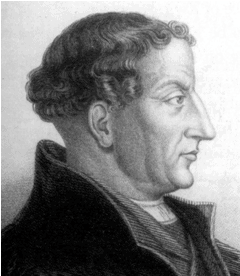This is part three of “The Long Road to Reform.”
In our last episode we looked at The Conciliar Movement that formed to end the Great Papal Schism and so many hoped would be a permanent fixture for reform in the Church. As well-intentioned as the movement was, it ended up resurrecting the Schism instead of solving it. In its long battle with the Papacy, Conciliarism eventually lost.
We turn now to look at a reformer from Bohemia named John Hus; or more properly Jan Hus. One of my personal, all-time favorite church leaders.
Bohemia was an important part of the Holy Roman Empire; a sovereign state with its capital at Prague. Today, it roughly corresponds with the Czech Republic. It had a long history as a place of vibrant Christianity, especially monasticism. In 1383, Bohemia and England were linked by the marriage of Anne of Bohemia and the English King Richard II. With this union, students of both countries went back and forth between the colleges of Prague and Oxford where the pre-reformer John Wycliffe.
The revolt Wycliffe started at Oxford, expanded when he was booted and met with greater success in Bohemia than England because unlike England, it was joined to a strong national party led by a man named Jan Hus.
Hus came from peasant parents in the southern Bohemian town of Husinetz. He studied theology at the University of Prague, earning a Master of Arts before teaching there and diving into the cause of religious reform.
While a student, Hus was introduced to the early philosophy of Wycliffe, but it was only after his appointment as the pastor at Bethlehem Chapel that was exposed to Wycliffe’s more radical views on religious reform. He immediately adopted Wycliffe’s views that the church was an invisible company of the elect, with Jesus as its head rather than a Pope.
Bethlehem Chapel was located near the University of Prague, giving Hus an open door to circulate Wycliffe’s writings. As his ideas took hold, paintings began to appear on the walls of the church contrasting the behavior of the popes and Christ. In one, the pope rode a horse while Jesus walked barefoot. Another showed Jesus washing the disciples’ feet as the pope’s were kissed.
Bethlehem Chapel had been founded in 1391 to encourage the national faith of Bohemia, so Hus’s strong sermons in Bohemian stirred up popular support for reform. And wouldn’t you know it? Where do you think the first protests came from–That’s right: Students rioted both for and against the ideas of Wycliffe being promoted by Hus and his supporters.
The Archbishop of Prague realized the threat Hus’s activities had for the upper echelons of Church Hierarchy and complained to the pope. The Pope responded, “Root out the heresy.” So the Archbishop excommunicated Hus. Bad move; for right away the Archbishop realized how little local support he had. When Hus realized he held the backing of the people, he ramped up his criticisms and attacked the pope’s sale of indulgences to support of his war against Naples. That was too much for the Bohemian King Wenceslas. Hus might have the support of the common people, but his condemnation of the sale of indulgences impacted a political issue the king didn’t want messed with. Negotiations between the Pope and king saw Prague being placed under a papal interdict; a political and religious slap on the wrist that had an immediate impact on people across the board. When under an interdict, people remained members of the church, but the sacraments were suspended. All of this happened because of Hus, so he left Prague to live in exile in southern Bohemia. It was during this time Hus wrote his most notable work, titled On the Church.
The Council of Constance we recently looked at was fast approaching. This was the council set to solve the problem of the Great Papal Schism. At the urging of the Emperor Sigismund, Hus agreed to appear. He hoped to present his views on the nature of the Church to the members of the Council. He ended up instead a victim of the Inquisition.
The rule of the Inquisition was simple. If enough witnesses testified to the guilt of the accused, he had to confess and renounce his error or he’d be executed by being burned, because, well – being good churchmen, they couldn’t shed blood. If the accused confessed, the sentence was life in prison, which in most cases was hardly better than being burnt at the stake. Hus’s case was handled in a manner typical for the Inquisition of that time. Greedy Inquisitors often went after someone simply because they lusted for their property. So people were accused of some grievous crime and there were usually enough witnesses-for-hire around who’d say whatever the Inquisitors paid them to. In Hus’s case, the Inquisitors weren’t after his wealth; the Church simply wanted him gone, so he was accused and found guilty of heresies he’d never taught.
Now, Hus said he’d alter his views—IF they could be shown to be contrary to Scripture. But he refused to recant the heresies he’d been falsely accused of. It was a matter of principle; to recant of them, he’d have to admit he taught them. He hadn’t. How could he recant something he’d never taught? But the Inquisitors were adamant: Hus must recant.
In words similar to what Martin Luther would say some time later while on Trial at Worms, Hus said, “I have said that I would not, for a chapel full of gold, recede from the truth. . . . I know that the truth stands and is mighty forever, and abides eternally, with whom there is no respect of persons.”
It’s clear in the letters Hus wrote at this time his main anxiety was that “liars would say I’ve slipped back from the truth I preached.” This trial of Hus is one of those special stand-out moments in church history. His fidelity and refusal to swerve from Truth, even to save his life was duplicated many times over by thousands of the un-named, but it was Hus who forged the template.
For 8 months he lay in prison in Constance. His letters during his last month rank among the great in Christian literature.
“O most holy Christ,” he prayed, “draw me, weak as I am, after Yourself, for if You do not draw us we cannot follow You. Strengthen my spirit, that it may be willing. If the flesh is weak, let Your grace precede us; come between and follow, for without You we cannot go for Your sake to cruel death. Give me a fearless heart, a right faith, a firm hope, a perfect love, that for Your sake I may lay down my life with patience and joy. Amen.”
On July 6th, 1415 Jan Hus was led out of his cell and began the walk to the place where he was to be burned. On the way he passed thru a churchyard and saw a bonfire of his books. He laughed, and told those looking on not to believe the lies being passed around about him. On arriving at the stake in a spot called The Devil’s Place, Hus knelt and prayed. Following protocol, the official in charge of the execution asked him for the final time if he’d recant and save his life. Hus replied, “God is my witness that the evidence against me is false. I have never thought nor preached except with the one intention of winning men, if possible, from their sins. In the truth of the gospel I have written, taught, and preached; today I will gladly die.”
The Inquisitors thought Hus’s condemnation and execution would put the kibosh on the calls for Reform. They thought burning Hus was a kind of back-fire that would put out the forest-fire lit by Wycliffe’s criticisms. They couldn’t have been more wrong. The Bohemian rebellion grew and developed into both a moderate and a militant wing. The moderates were called Utraquists, a Latin term meaning “both” since their protest called for freedom to receive both the bread and the cup in Communion.
The militants were called Taborites after the city in Bohemia that served as their headquarters. This was an apocalyptic group that called for radical reform.
Facing armed resistance from the Bohemian King at the urging of the Pope, the various groups of Hus’s followers, loosely called Hussites, agreed to what’s called The Four Articles. Under the Articles, while the various groups might differ on this or that, they were far more united with each other in facing the King. The Four Articles were, à
1) The Word of God was regarded as the chief authority and was to be taught freely throughout the kingdom.
2) Per the Ultraquists, Communion would be given by BOTH bread and cup.
3) All agreed that clergy should give up their wealth and live in apostolic poverty.
4) Simony and any other public sin was to be punished.
When King Wenceslas died in 1419, his successor was Sigismund, the guy who’d failed Hus at Constance. The Hussites demanded he agree to the Four Articles and grant them freedom of worship. Sigismund refused and petitioned the Pope to proclaim a Crusade against them. The Pope agreed and Sigismund marched on Prague where he and his army was crushed by the Hussites.
Their leader was Jan Zizka who turned the many peasant carts into a kind of war chariot. In a follow up battle, the remnant of Sigismund’s army was wiped out. Then, a year later, an army of a hundred thousand crusaders fled yet again before Zizka’s carts. A 3rd Crusade, a year after that, in 1422, dissolved before it even met them.
Under different leaders, the Bohemians crushed 2 later Crusades called against them, one in 1427 and the other in 31. The Council of Basel extended an olive branch to the Hussites, but they, fearing the same treatment Hus had met at Constance, refused. So yet ANOTHER Crusade was called against them. This was also put down. Good Grief! When are these people going to learn?
Actually, this defeat convinced the Catholics negotiation with the Hussites was necessary. As a result of that negotiation, the church in Bohemia rejoined the rest of Western Christendom, but was allowed to retain Ultraquist communion as well as a modified form of the Four Articles.
While most of the nobility accepted this arrangement and honored Sigismund as King, many of the commoners left the Church, and formed the Unitas Fratrum—or “Union of Brethren.” Their numbers grew in Bohemia and nearby Moravia.
They’ll become closely aligned with the Reformation later.
What the lives of Wycliffe and Hus make clear is that if the Church of Rome was going to be reformed from within, it had ample opportunity in the 14th and early 15th Cs. By the end of the 15th , those who hoped to bring reform by councils were themselves frustrated and by their opponents, repudiated. The treatment of Wycliffe and Hus by church authorities made clear to all the reform-minded how they were going to be dealt with. It was now clear: Reform of the papal church from within was impossible. A time of “judgment” had come.
In our next episode, we’ll take a look at an Italian Reformer from a bit later in the 15th C; Savonarola.






Just to note that language of Czechs is Czech. That Bohemia (as distinct from Czech) is a mess which you would rather ignore or you fall into pits of turd (e.g., German – Czech hatred of 19th century).
Thanks Matej